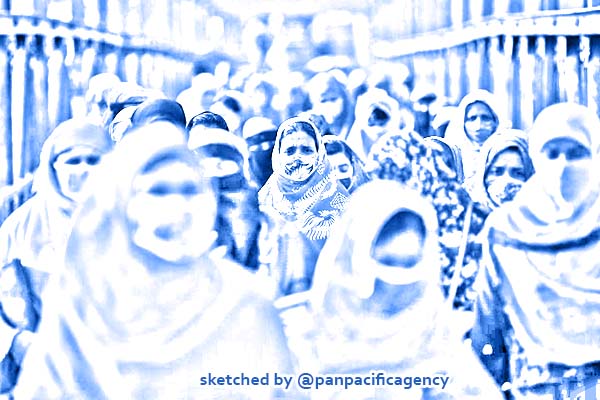[Analytics] What the pandemic means for the Bangladeshi garments and world’s fashion

Bangladeshi garments industry workers are more worried about their income than about coronavirus. REUTERS. Sketched by the Pan Pacific Agency.
It took some time for the Bangladesh garments industry to get back to business after the Rana Plaza tragedy, a wake-up call for the industry. Shahidur Rahman specially for the Dhaka Tribune.
Since then, more than a hundred programs have been introduced by the stakeholders and among them the most effective initiatives are Accord and Alliance. Another notable but complex project is Brac University’s Mapped in Bangladesh project (Formerly known as digital RMG factory mapping in Bangladesh).
The project is funded by Laudes Foundation (previously known age C&A Foundation) and the Embassy of the Kingdom of the Netherlands. As a result of these initiatives, the moment we thought we had overcome the consequences of Rana Plaza and would achieve the $50 billion target of export earnings by 2021, our dream was been washed away by Covid-19, a pandemic that has shattered the global economy at this moment.
For the sake of survival, the whole world has been campaigning for social distancing and lockdown, which has triggered the shutdown of stores of retailers and buyers.
At the end of April 2020, orders for more than $3.17 billion had been cancelled, reported by 1,149 factories in Bangladesh. Anner’s study (2020) shows that more than half of the suppliers have had the bulk of their in-process, or already completed, production cancelled. Cancellation of these current orders means a loss of resources with an imminent threat to the RMG backward linkage industries, as 72.1% of buyers refused to pay for the raw materials already purchased by the suppliers.
However, 14 brands, including H&M and C&A have agreed that they will take their export orders, in contrast to the long list of brands refusing to pay for goods workers have already made for them. A C&A spokesperson said: “We are working hard to minimize the impact on our suppliers and intend to accept all goods that have left the factory. We are in close contact with our suppliers to find flexible, individual arrangements also for garments currently in production.”
However, the cancellation of orders has directly affected the lives of 2.27 million workers. According to a study by Brac James P Grant School of Public Health and Bangladesh Health Watch, 47% of the garment workers reportedly underlined that they had no income currently.
On April 15, 2020 hundreds of workers staged demonstrations, demanding their salaries for March. Bangladesh garment factories were set to open on April 5, causing workers to return to Dhaka, the most densely populated city in the world with 10 million inhabitants. This decision of reopening garment factories had been taken even though there was a government enforced nationwide shutdown to combat the spread of coronavirus.
Therefore, while public transport is not in operation, these garment workers had to walk for 15 to 20 hours without a break to reach the factories in time. With limited financial affordability, these garment workers are more worried for job loss than coronavirus.
Therefore, many of them wearing masks decided to start walking, travelled in crammed pick-up vans and trucks meant for carrying goods, to resume their work. To these garment workers, most of whom are women, securing the job seems to be more important than staying at home to protect them from the pandemic.
The Covid-19 has pushed the BGMEA into a difficult position to decide whether or not to close the factories. On one hand, there has been a pressure from the suppliers to keep the factories open for the sake of survival of the business. On the other hand, trade unions and activists from around the world are worried of the lives of the garment workers and expect to close down the factories.
Although, the BGMEA initially has urged the owners to close their factories, it later allowed production in the factories which have export orders and who are producing products to protect from coronavirus.
Now, it seems there is a difficult choice for the government — saving lives or the economy. Bangladesh is considered as a role model for other developing economies in achieving sustainable development. Bangladesh has the fastest-growing economy in the Asia-Pacific region and lately, it’s been closing in on double-digit annual growth in its GDP.
This achievement has been under threat due to the impact of the pandemic on the economy. In 2019, 20% people were below the poverty line but within a month after the pandemic it has increased to 30% ie, 50 million people. The global strategy of lockdown, as argued by the policy-makers, seems to be ineffective in a country like Bangladesh where the informal economy contributes to more than 80% of the economy and the garment sector is the dominant export earning sector.
The government has announced a stimulus package of $590 million for the RMG industry in efforts to face the possible impact of the coronavirus on the economy. The garment entrepreneurs can avail this government fund as a loan for the purpose of paying wages and allowances to the workers and other employees. But the question is — how long can the government provide such safety net?
The fast fashion model, until this pandemic, has made unprecedented successes relying on the cheap labour of the Bangladesh RMG as well as the capacity of the suppliers. It is not the high time to abandon them. As Jette said: “The model of fast fashion needs Bangladesh, and Bangladesh in turn needs fast fashion.”
Shahidur Rahman is a Professor of Sociology in the Department of Economics and Social Sciences at Brac University.